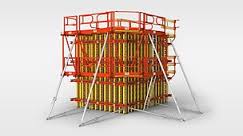 Scaffolding requires specific tools. Proper equipment is as important as training. If you want your project to be compliant with all the legal requirements as well as with the current market in Christchurch NZ, you need to start with the right tools.
Scaffolding requires specific tools. Proper equipment is as important as training. If you want your project to be compliant with all the legal requirements as well as with the current market in Christchurch NZ, you need to start with the right tools.
The framing
Frames are essential in scaffolding. Do not mistake these for formwork Auckland, which is set into place so you can pour concrete or similar materials. These can be either metallic engineered system or traditional timber ones, or other options, such as reusable plastic or flexible materials and are totally different from scaffold framing. You need poles and bars to generate the main structure of the scaffold.
Platform tools
You workers need to stand, walk and sit on a surface. Build this using wooden planks, steel or aluminum. Make sure you use it at the best fitting size, according to the frames employed. Get help from a scaffold hire Christchurch contractor if you can’t seem to get a perfect match.
Cross bars
Cross bars are tools that ensure structure durability and safety. You usually see these as diagonally places bars that form triangles. They prevent workers from falling off and strengthen the structure.
Base plates for poles
Poles may sink into the ground under great pressure. For this reason you need to use a base plate with each of the poles that support a lot of weight – especially the ones on ground level. The solution is also effective when the ground is uneven or slippery, as it adds extra stability to the scaffolding structure.
Netting
In streets or generally crowded areas, you will need to employ safety netting, to prevent materials that may fall from hitting pedestrians or anyone standing below.
Level tool
Scaffolding safety and efficiency depend on a level ground. It’s best to use an electronic level, for ultimate precision. You need to make sure the surface is not inclined.
Measuring tools
Ideally, you will employ a tape measure. Plan carefully before you build and make everything in accordance with the New Zealand safety regulations.
Socket sets
A socket set is a must, because otherwise you cannot tighten clamps and similar parts. You may use spanners, too. It will also let you loosen nuts faster, so you’ll get to save plenty of precious time.
Hammers
Make sure to have the right type of hammer for the work. Scaffolders usually employ claw hammers. They can handle pins and clamps (both driving and pulling) as you assemble and disassemble the scaffold.
Protection equipment
Finally, you need to ensure proper protective equipment for all workers and supervisors too. Hard hats and boots are essential, but also you must not forget the high visibility jackets. Get safety harnesses and, when necessary, eye and ear protection.
